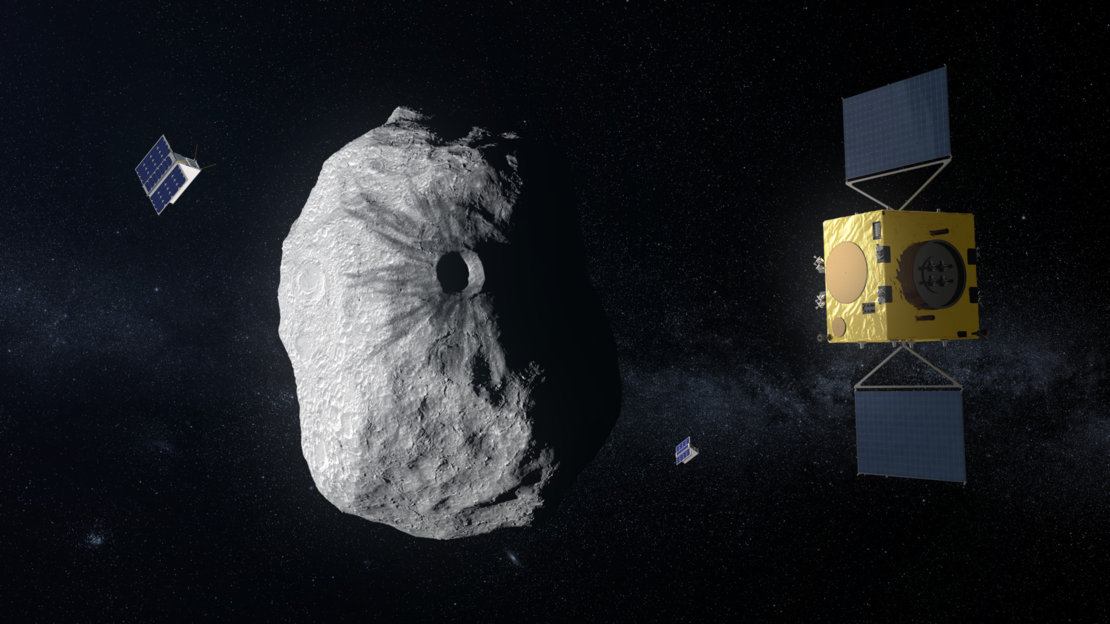Two little cubesats will fly with a planned European asteroid mission to get some extra space-rock studies done.
The candidate Hera mission to the two-asteroid Didymos system will include two briefcase-size spacecraft, European Space Agency (ESA) officials announced last Monday (Jan. 7).
"We're very happy to have these high-quality cubesat missions join us to perform additional bonus science alongside their Hera mothership," Hera manager Ian Carnelli said in a statement. [The Greatest Asteroid Encounters of All Time!]
"Carrying added instruments and venturing much closer to our target bodies, they will give different perspectives and complementary investigations on this exotic binary asteroid," Carnelli added. "They will also give us valuable experience of close proximity operations relayed by the Hera mothercraft in extreme low-gravity conditions. This will be very valuable to many future missions."
The binary asteroid system consists of the 2,550-foot-wide (780 meters) Didymos and its 525-foot (160 m) satellite, dubbed "Didymoon."

NASA plans to launch a planetary-defense mission called DART (Double Asteroid Redirection Test) toward these rocks in mid-2021. If all goes according to plan, DART will slam into Didymoon in October 2022. Telescopes here on Earth will then scrutinize Didymoon's path around its parent rock, gauging how much the impact affected the moon's orbit.
Such information will help researchers better understand the "kinetic impactor" asteroid-deflection technique, one of the strategies humanity could use to deal with a space rock that lines Earth up in its crosshairs.
Get the Space.com Newsletter
Breaking space news, the latest updates on rocket launches, skywatching events and more!
Hera is part of this picture as well. The proposed mission would study the crater blasted out by DART and get up-close measurements of Didymoon's shifted orbit. (A decision about whether to fly Hera is expected toward the end of this year, ESA officials have said.)
Current plans call for Hera to launch in 2023 and get to the Didymos system in 2026. An earlier incarnation of the concept, the Asteroid Impact Mission, called for a larger and more expensive ESA spacecraft, which would have gotten to Didymos before DART and observed the impact.
The newly selected Hera cubesats are the Asteroid Prospection Explorer (APEX), which was provided by a Swedish-Finnish-Czech-German consortium, and Juventas, which was developed by the Danish company GomSpace and the Romanian company GMV.
APEX will study the surface composition and interior structure of Didymos and Didymoon, and Juventa will investigate Didymoon's gravity field and structure. Both cubesats will perform asteroid landings, ESA officials said.
APEX and Juventa won't be the first cubesats to explore deep space. NASA's twin MarCO probes blazed that trail last year when they flew along with the American space agency's InSight Mars lander. The MarCO mission beamed home data from InSight during the lander's touchdown in November 2016, helped researchers gather data about the Martian atmosphere and captured imagery of the Red Planet. (The cubesats didn't follow InSight onto Mars' surface; both probes flew past the Red Planet, their missions complete at that point.)
And more than a dozen cubesats are manifested on the first flight of NASA's huge new Space Launch System rocket, which is known as Exploration Mission-1. EM-1, which is scheduled to launch in June 2020, will send NASA's Orion capsule on an uncrewed voyage around the moon.
Among the EM-1 cubesats are Lunar Flashlight, which will hunt for lunar water ice, and Near-Earth Asteroid Scout, which will use a solar sail to cruise to a space rock and study it up close.
DART may also fly with a cubesat — a probe called Light Italian Cubesat for Imaging of Asteroids, which would be provided by the Italian Space Agency.
Mike Wall's book about the search for alien life, "Out There" (Grand Central Publishing, 2018; illustrated by Karl Tate) is out now. Follow him on Twitter @michaeldwall. Follow us @Spacedotcom or Facebook. Originally published on Space.com.
Join our Space Forums to keep talking space on the latest missions, night sky and more! And if you have a news tip, correction or comment, let us know at: community@space.com.

Michael Wall is a Senior Space Writer with Space.com and joined the team in 2010. He primarily covers exoplanets, spaceflight and military space, but has been known to dabble in the space art beat. His book about the search for alien life, "Out There," was published on Nov. 13, 2018. Before becoming a science writer, Michael worked as a herpetologist and wildlife biologist. He has a Ph.D. in evolutionary biology from the University of Sydney, Australia, a bachelor's degree from the University of Arizona, and a graduate certificate in science writing from the University of California, Santa Cruz. To find out what his latest project is, you can follow Michael on Twitter.









